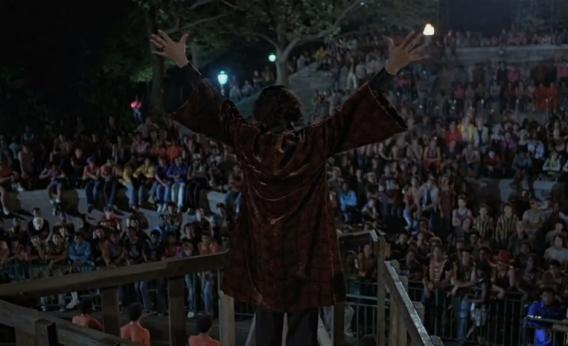The author Sol Yurick died over the weekend in his late 80s.* The author of several books, he is best known for his first, the 1965 novel The Warriors, which inspired the 1979 movie of the same name. That movie in turn inspired Nike commercials, a popular video game, countless hip-hop tracks and music videos, the novelist Jonathan Lethem, and some of the most memorable performances of basketball player Shaquille O’Neal.
Today, Walter Hill’s adaptation of The Warriors is remembered as a cult classic, and is rightly appreciated for its visual flair and camp value more than for its historical accuracy. But when Yurick set out to write his novel about the street gangs of the Bronx, he was aiming for something more than a wildly caricatured action romp. The son of communists and union activists, Yurick was intensely interested in using literature to cast a light on the impoverished lives of New York City’s neglected youth. In an obituary for the Guardian, Eric Homberger describes the extraordinary lengths Yurick went to in researching his novel:
While working with poor families, he encountered children who were members of street gangs. He found it impossible to talk to them directly about gang life; they would tell him only what they believed he wanted to hear. A rented panel truck gave him a way to observe them secretly. He walked the streets where the gangs ruled, and once went on foot through the subway tunnel between 96th Street and 110th Street. It was a scary experience. He wanted to show that street gangs, universally seen as a symptom of social dysfunctionality, gave to the poor a structure of loyalty and a sense of community. They were neither sick, nor bad, only poor.
When Yurick finally saw the film adaptation, 14 years after his book’s release, he was dismayed. Yurick’s novel was a gritty account that went out of its way to establish parallels with Xenophon’s Anabasis, the classic Greek tale about soldiers fighting their way out of enemy territory (thus the name Cyrus, for the guy who says “Can you dig it?”). But the movie adaptation was romanticized and sensationalized, and included outlandish gangs like the mime-styled Hi-Hats and the Baseball Furies.
Still, the movie didn’t lose all connection to reality. Indeed, fans of The Warriors who appreciate the film for its costuming, dialogue, and music video-like compositions may be surprised by its overlapping with actual New York City history—yes, even some of those cut-sleeve-flyin’ styles. This is in large part due to Yurick’s research, but other aspects of the film seem to have been inspired by events even Yurick couldn’t have predicted. In Can’t Stop Won’t Stop, Jeff Chang’s definitive history of hip-hop’s rise out of the Bronx, Chang tells the story of the actual peace meeting of the Bronx street gangs. It is, in many surprising ways, just like the famous opening of The Warriors:
And so they came, the Black and brown gangs of the Bronx. The smaller families—the Liberated Panthers, the King Cobras, the Majestic Warlocks, the Ghetto Warriors, the Flying Dutchmen. The hungry ones—the Young Sinners, the Young Cobras, the Young Saints, the Young Saigons, the Roman Kings. The established ones — the Turbans, the Brothers and Sisters, the Latin Aces, the Peacemakers, the Dirty Dozens, the Mongols. And the major families, the Javelins, the Bachelors, the Savage Nomads, the Savage Skulls, the Black Spades, and the Seven Immortals.
The unprecedented gathering threatened to explode from the accumulated fuel of unresolved slights and unpaid blood debts. Sniper cops perched on the roofs of nearby buildings. Television cameras, photographers and reporters filed into the gym …
After Ghetto Brothers leader Charlie Suarez got the last of the police to leave, the gangs began the meeting. One attendee later remembered the occasion, which included “someone hanging upside down, someone drinking, someone throwing a knife at a board,” as “a wild and crazy scene, like something out of a movie.”
But while some of the movie’s most striking details had their basis in an actual chapter of New York City history, the historical peace talks ended differently. Though it wouldn’t last forever, all the gangs’ presidents put their hands together to pledge “PEACE BETWEEN ALL GANGS AND A POWERFUL UNITY.” Can you dig that?
* This post originally misstated Yurick’s age.
